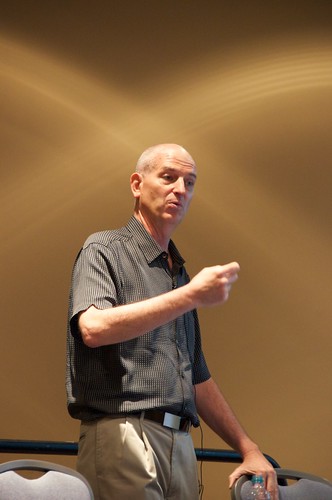I noticed it, that the presentations and workshops I was attending at ISTE this week were more effectively delivered, compelling, and entertaining than I remember from past conferences. I assumed that it was because of luck — I happened to be in the right place at the right time. But then I started hearing the same thing from other attendees, that the sessions they were attending were better than they’d experienced before.
So, having thought a bit about it, I’d like to speculate on some possible reasons. Mind you, these are only speculations.
- Luck – This is certainly a possibility (or probability), that I was talking with folks who were, like me, ISTE-charmed, draw to those presentations and presenters that fulfilled and exceeded their conference expectations.
- Presenters are simply better – Frankly, most of the sessions that I attended were presented by people who were accustomed to presenting at conferences. But I heard more than once about renowned speakers who had simply improved substantially over the past year. What I do at conference, I would have to consider to be a craft. I work to refine and improve my craft as I’m sure all of us do.
- Presenters getting smarter – I suspect that this might be one of the weightier potential reasons — and it is not that we’re increasing our brain mass and capacity. But I suspect that as we increase and refine our skills at cultivating and learning from our networks, we are collecting and contextualizing more ideas, opportunities, and resources more effectively and efficiently than ever before.
- Presentation software is Better – Here’s another one that comes from my own experience. Prezi, the single canvas, zoom, and twirl presentation software from Hungary, significantly effected my presentations in several positive ways. For one, it altered the way that I planned my presentations, as I was working with one document rather than many. Since switching back to Apple Keynote, I’m back to slide decks. But the astounding build and transition capabilities of this software has given me a richer tool box for expressing complex ideas with motion and sequence. I hope that I’m doing that well.
- The message is better – We seem to be talking less about test-prep and a lot more about exciting new pedagogies. We may even be talking less about gadgets and more about their application. I would love to see or do some research on presentation descriptions and their inclusion of various flag words to test this out.
Again, these are merely speculations — food for thought. But I think it is a legitimate question for us to be asking right now, right after ISTE 2011. Are we beginning to mature as a movement? ..and if so, how and where do we go from here?






 This afternoon, however, with a couple of hours in my office after flying in from Omaha and getting on the train for Philly in the morning, I did a search on
This afternoon, however, with a couple of hours in my office after flying in from Omaha and getting on the train for Philly in the morning, I did a search on  Directly beneath is a slide’able alphabetical listing of presenters and exhibitors with popout details. The exhibitor details can click out into a map of the vendor hall. Now that could be handy.
Directly beneath is a slide’able alphabetical listing of presenters and exhibitors with popout details. The exhibitor details can click out into a map of the vendor hall. Now that could be handy.



 I’m among the first to arrive at
I’m among the first to arrive at